Identification of Attribution of Runoff Variations in the Tumen River Basin Based on Budyko’s Hypothesis
Abstract
1. Introduction
2. Materials and Methods
2.1. Study Area
2.2. Data
2.3. Methodology
2.3.1. Moving Average
2.3.2. Mann–Kendall Test
2.3.3. Cumulative Anomaly Method
2.3.4. Runoff Elasticity
3. Results
3.1. Runoff Variation Analysis
3.2. Climatic Element Analysis
3.3. Land Utilization Transformation Analysis
3.4. Analysis of Runoff Variations Attribution
4. Discussion
4.1. Runoff Response in the TRB Under Changing Environments
4.2. Applicability and Limitations of the Budyko Framework in the TRB
5. Conclusions
Author Contributions
Funding
Data Availability Statement
Conflicts of Interest
Appendix A
| Extreme Temperatures | Average | Max | Year | Min | Year | Trend Rate/10a | Trend | Significance (p) |
|---|---|---|---|---|---|---|---|---|
| TX10P | 37.09 | 77 | 1969 | 14 | 1961 | −2.67 | Decline | <0.05 |
| TN10P | 36.81 | 96 | 1969 | 8 | 1994 | −6.83 | Decline | <0.05 |
| TX90P | 37.66 | 67 | 2019 | 11 | 2012 | 2.72 | Rise | <0.05 |
| TN90P | 37.46 | 78 | 2021 | 8 | 1965 | 5.86 | Rise | <0.05 |
| FD0 | 179.00 | 198 | 1962 | 159 | 1998 | −2.25 | Decline | <0.05 |
| ID0 | 88.00 | 114 | 1956 | 69 | 1995 | −1.58 | Decline | <0.05 |
| SU25 | 64.94 | 84 | 1977 | 44 | 1986 | 2.04 | Rise | <0.05 |
| TR20 | 7.65 | 23 | 2021 | 0 | 1957 | 1.23 | Rise | <0.05 |
| TNn | −26.64 | −21.52 | 1996 | −31.94 | 1972 | 0.64 | Rise | <0.05 |
| TXx | 33.54 | 36.73 | 2010 | 30.44 | 1957 | 0.15 | Rise | >0.05 |
| Extreme Precipitation | Average | Max | Year | Min | Year | Trend Rate/10a | Trend | Significance (p) |
|---|---|---|---|---|---|---|---|---|
| Rxlday | 47.65 | 107.89 | 1965 | 14.39 | 2011 | 0.99 | Rise | >0.05 |
| Rx5day | 78.68 | 182.62 | 1965 | 27.6 | 2011 | 1.42 | Rise | >0.05 |
| R95p | 140.98 | 369.9 | 1994 | 25.8 | 1977 | 7.79 | Rise | >0.05 |
| R99p | 47.2 | 213.6 | 1965 | 0 | 1956 | 3.59 | Rise | >0.05 |
| SDII | 6.86 | 9.5 | 1961 | 4.4 | 1967 | 0.09 | Rise | >0.05 |
| CDD | 54 | 132 | 2011 | 22 | 1990 | 0.86 | Rise | >0.05 |
| CWD | 7 | 13 | 1989 | 4 | 1964 | −0.07 | Decline | >0.05 |
| R10mm | 16 | 24 | 1966 | 8 | 1967 | 0.19 | Rise | >0.05 |
| R20mm | 5 | 12 | 1994 | 0 | 1967 | 0.28 | Rise | >0.05 |
| R25mm | 3 | 8 | 1994 | 0 | 1967 | 0.15 | Rise | >0.05 |
References
- Linnenluecke, M.K.; Smith, T. A Primer on Global Environmental Change. Abacus 2019, 55, 810–824. [Google Scholar] [CrossRef]
- Farsi, N.; Mahjouri, N. Evaluating the contribution of the climate change and human activities to runoff change under uncertainty. J. Hydrol. 2019, 574, 872–891. [Google Scholar] [CrossRef]
- Neelin, J.D.; Martinez-Villalobos, C.; Stechmann, S.N.; Ahmed, F.; Chen, G.; Norris, J.M.; Kuo, Y.-H.; Lenderink, G. Precipitation extremes and water vapor: Relationships in current climate and implications for climate change. Curr. Clim. Change Rep. 2022, 8, 17–33. [Google Scholar] [CrossRef]
- Zhang, Z.; Wan, L.; Dong, C.; Xie, Y.; Yang, C.; Yang, J.; Li, Y. Impacts of Climate Change and Human Activities on the Surface Runoff in the Wuhua River Basin. Sustainability 2018, 10, 3405. [Google Scholar] [CrossRef]
- Du, Y.; Bao, A.; Zhang, T.; Ding, W. Quantifying the impacts of climate change and human activities on seasonal runoff in the Yongding River basin. Ecol. Indic. 2023, 154, 110839. [Google Scholar] [CrossRef]
- The Water Cycle|U.S. Geological Survey [EB/OL]. Available online: https://www.usgs.gov/media/images/shuixunhuan-water-cycle-simplified-chinese-png (accessed on 5 November 2022).
- Tang, G.P.; Li, X.B.; Liu, Y.H. Vulnerability of water resources to global climate change and its assessment methods. Prog. Earth Sci. 2000, 15, 5. [Google Scholar] [CrossRef]
- Yang, D.; Yang, Y.; Xia, J. Hydrological cycle and water resources in a changing world: A review. Geogr. Sustain. 2021, 2, 115–122. [Google Scholar] [CrossRef]
- Tan, X.; Tan, X.; Liu, B.; Huang, Z. Contribution of changes in vegetation composition and climate variability on streamflow across the global watersheds. Catena 2023, 232, 107394. [Google Scholar] [CrossRef]
- Su, J.; Zhang, P.; Deng, X.; Ren, C.; Zhang, J.; Chen, F.; Long, A. Predicting Runoff from the Weigan River under Climate Change. Appl. Sci. 2024, 14, 541. [Google Scholar] [CrossRef]
- Zare, M.; Samani, A.A.N.; Mohammady, M. The impact of land use change on runoff generation in an urbanizing watershed in the north of Iran. Env. Earth Sci. 2016, 75, 1279. [Google Scholar] [CrossRef]
- Sajikumar, N.; Remya, R.S. Impact of land cover and land use change on runoff characteristics. J. Environ. Manag. 2015, 161, 460–468. [Google Scholar] [CrossRef] [PubMed]
- Ahmed, N.; Wang, G.; Booij, M.J.; Sun, X.; Hussain, F.; Nabi, G. Separation of the impact of landuse/landcover change and climate change on runoff in the upstream area of the Yangtze River, China. Water Resour. Manag. 2022, 36, 181–201. [Google Scholar] [CrossRef]
- Wang, T.; Shi, R.; Yang, D.; Yang, S.; Fang, B. Future changes in annual runoff and hydroclimatic extremes in the upper Yangtze River Basin. J. Hydrol. 2022, 615, 128738. [Google Scholar] [CrossRef]
- Wang, D.L.; Feng, H.M.; Zhang, B.Z.; Wei, Z.; Tian, Y.L. Quantifying the impacts of climate change and vegetation change on decreased runoff in China’s yellow river basin. Ecohydrol. Hydrobiol. 2022, 22, 310–322. [Google Scholar] [CrossRef]
- Tang, J.; Wang, W.; Cheng, H.; Jin, H.; Zhao, T.; Xie, Y. Changes in runoff and sediment discharge along with their driving factors in the Pearl River basin from 1961 to 2018. Int. J. Sediment Res. 2024, 39, 386–400. [Google Scholar] [CrossRef]
- Liu, H.; Liu, J.; Chen, W. Effects of climate and land use change on runoff of the Second Songhua River Basin guided by SWAT model. Water Supply 2024, 24, 707–722. [Google Scholar] [CrossRef]
- Li, Z.; Wu, Y.; Li, J.; Qi, P.; Sun, J.; Sun, Y. Attribution Analysis of Runoff Variation in the Second Songhua River Based on the Non-Steady Budyko Framework. Water 2023, 15, 451. [Google Scholar] [CrossRef]
- Carmona, A.M.; Renner, M.; Kleidon, A.; Poveda, G. Uncertainty of runoff sensitivity to climate change in the Amazon River basin. Ann. N. Y. Acad. Sci. 2021, 1504, 76–94. [Google Scholar] [CrossRef]
- Yin, S.; Gao, G.; Li, Y.; Xu, Y.J.; Turner, R.E.; Ran, L.; Wang, X.; Fu, B. Long-term trends of streamflow, sediment load and nutrient fluxes from the Mississippi River Basin: Impacts of climate change and human activities. J. Hydrol. 2023, 616, 128822. [Google Scholar] [CrossRef]
- Melesse, M.B.; Demissie, Y. Hydrology and droughts in the nile: A review of key findings and implications. Water 2024, 16, 2521. [Google Scholar] [CrossRef]
- Pekárová, P.; Halmová, D.; Sabová, Z.; Pekár, J.; Miklánek, P.; Mitková, V.B.; Prohaska, S.; Kohnová, S.; Garaj, M. Sensitivity of runoff due to changes in the characteristics of the water balance in the Danube River region. J. Hydrol. Hydromech. 2023, 71, 399–412. [Google Scholar] [CrossRef]
- Tsarouchi, G.; Buytaert, W. Land-use change may exacerbate climate change impacts on water resources in the Ganges basin. Hydrol. Earth Syst. Sci. 2018, 22, 1411–1435. [Google Scholar] [CrossRef]
- Zhai, R.; Tao, F. Contributions of climate change and human activities to runoff change in seven typical catchments across China. Sci. Total Environ. 2017, 605, 219–229. [Google Scholar] [CrossRef] [PubMed]
- Zhang, Y.; Jin, R.; Zhu, W.; Zhang, D.; Zhang, X. Impacts of Land Use Changes on Wetland Ecosystem Services in the Tumen River Basin. Sustainability 2020, 12, 9821. [Google Scholar] [CrossRef]
- Shi, J.; Jin, R.; Zhu, W.; Tian, L.; Lv, X. Effects of multi-scale landscape pattern changes on seasonal water quality: A case study of the Tumen River Basin in China. Environ. Sci. Pollut. Res. 2022, 29, 76847–76863. [Google Scholar] [CrossRef]
- Zhang, P.; Liu, X.; Zhu, W.; Li, C.; Jin, R.; Yan, H.; Gu, C.; Wang, J. Spatio-temporal changes in water conservation ecosystem service during 1990–2019 in the Tumen River Basin, Northeast China. Chin. Geogr. Sci. 2023, 33, 102–115. [Google Scholar] [CrossRef]
- Zheng, X.J.; Sun, P.; Zhu, W.H.; Xu, Z.; Fu, J.; Man, W.D.; Li, H.L.; Zhang, J.; Qin, L. Landscape dynamics and driving forces of wetlands in the Tumen River Basin of China over the past 50 years. Landsc. Ecol. Eng. 2017, 13, 237–250. [Google Scholar] [CrossRef]
- Lian, Y.; Sun, M.; Wang, J.; Luan, Q.; Jiao, M.; Zhao, X.; Gao, X. Quantitative impacts of climate change and human activities on the runoff evolution process in the yanhe river basin. Phys. Chem. Earth 2021, 122, 102998. [Google Scholar] [CrossRef]
- Jin, L.; Zhang, Z. Assessing Environmental Sustainability in the Transnational Basin of the Tumen River Based on Remote Sensing Data and a Geographical Detector. Sustainability 2024, 16, 8121. [Google Scholar] [CrossRef]
- Chatfield, C.; Xing, H. The Analysis of Time Series: An Introduction with R; Chapman and Hall/CRC: Boca Raton, FL, USA, 2019. [Google Scholar]
- Mann, H.B. Nonparametric tests against trend. Econom. J. Econom. Soc. 1945, 13, 245–259. [Google Scholar] [CrossRef]
- Xu, X.; Yang, D.; Yang, H.; Lei, H. Attribution analysis based on the Budyko hypothesis for detecting the dominant cause of runoff decline in Haihe basin. J. Hydrol. 2014, 510, 530–540. [Google Scholar] [CrossRef]
- Zhang, S.; Liu, J.; Li, C.; Yu, F.; Jing, L.; Sun, J. Analyzing the Impact of Climate Change and Human Activities on Surface Runoff in the Changbai Mountain Area, Northeast China. Water 2021, 13, 3473. [Google Scholar] [CrossRef]
- Li, X.; He, H.S.; Li, N.; Yu, H.; Zong, S.; Wu, Z.; Du, H. Season-dependent climate sensitivity of the surface runoff of major rivers in Changbai Mountain. J. Hydrol. 2024, 643, 131936. [Google Scholar] [CrossRef]
- He, Y.; Song, J.; Hu, Y.; Tu, X.; Zhao, Y. Impacts of different weather conditions and landuse change on runoff variations in the Beiluo River Watershed, China. Sustain. Cities Soc. 2019, 50, 101674. [Google Scholar] [CrossRef]
- Zhang, J.; Yu, X. Analysis of land use change and its influence on runoff in the Puhe River Basin. Environ. Sci. Pollut. Res. 2021, 28, 40116–40125. [Google Scholar] [CrossRef]
- Ngwira, S.; Damazio, C. Quantification of the effects of climatic factors and anthropogenic activities on streamflow: A systematic review. Discov. Water 2025, 5, 31. [Google Scholar] [CrossRef]
- Chen, L.; Yang, M.; Liu, X.; Lu, X. Attribution and sensitivity analysis of runoff variation in the yellow river basin under climate change. Sustainability 2022, 14, 14981. [Google Scholar] [CrossRef]
- Shen, Q.; Cong, Z.; Lei, H. Evaluating the impact of climate and underlying surface change on runoff within the Budyko framework: A study across 224 catchments in China. J. Hydrol. 2017, 554, 251–262. [Google Scholar] [CrossRef]
- Demeke, G.G.; Huang, J.C.; Chen, Y.Y. Runoff Generation Signaled by Deviations from the Budyko Framework. Water Resour. Manag. 2024, 39, 2133–2148. [Google Scholar] [CrossRef]
- Wu, C.; Yeh, P.J.F.; Zhou, J.; Li, J.; Zhong, L.; Wang, S.; Gong, Z.; Shi, M.; Ju, J.; Huang, G. Controlling factors of evapotranspiration predictability under diverse climates with the effects of water storage change in the Budyko framework. Water Resour. Res. 2024, 60, e2023WR034499. [Google Scholar] [CrossRef]
- Talebmorad, H.; Ahmadnejad, A.; Eslamian, S.; Ostad-Ali-Askari, K.; Singh, V.P. Evaluation of uncertainty in evapotranspiration values by FAO56-Penman-Monteith and Hargreaves-Samani methods. Int. J. Hydrol. Sci. Technol. 2020, 10, 135–147. [Google Scholar] [CrossRef]
- Prudhomme, C.; Reed, D.W. Relationships between extreme daily precipitation and topography in a mountainous region: A case study in Scotland. Int. J. Climatol. A J. R. Meteorol. Soc. 1998, 18, 1439–1453. [Google Scholar] [CrossRef]
- Feng, M.; Zhang, W.; Zhang, S.; Sun, Z.; Li, Y.; Huang, Y.; Wang, W.; Qi, P.; Zou, Y.; Jiang, M. The role of snowmelt discharge to runoff of an alpine watershed: Evidence from water stable isotopes. J. Hydrol. 2022, 604, 127209. [Google Scholar] [CrossRef]
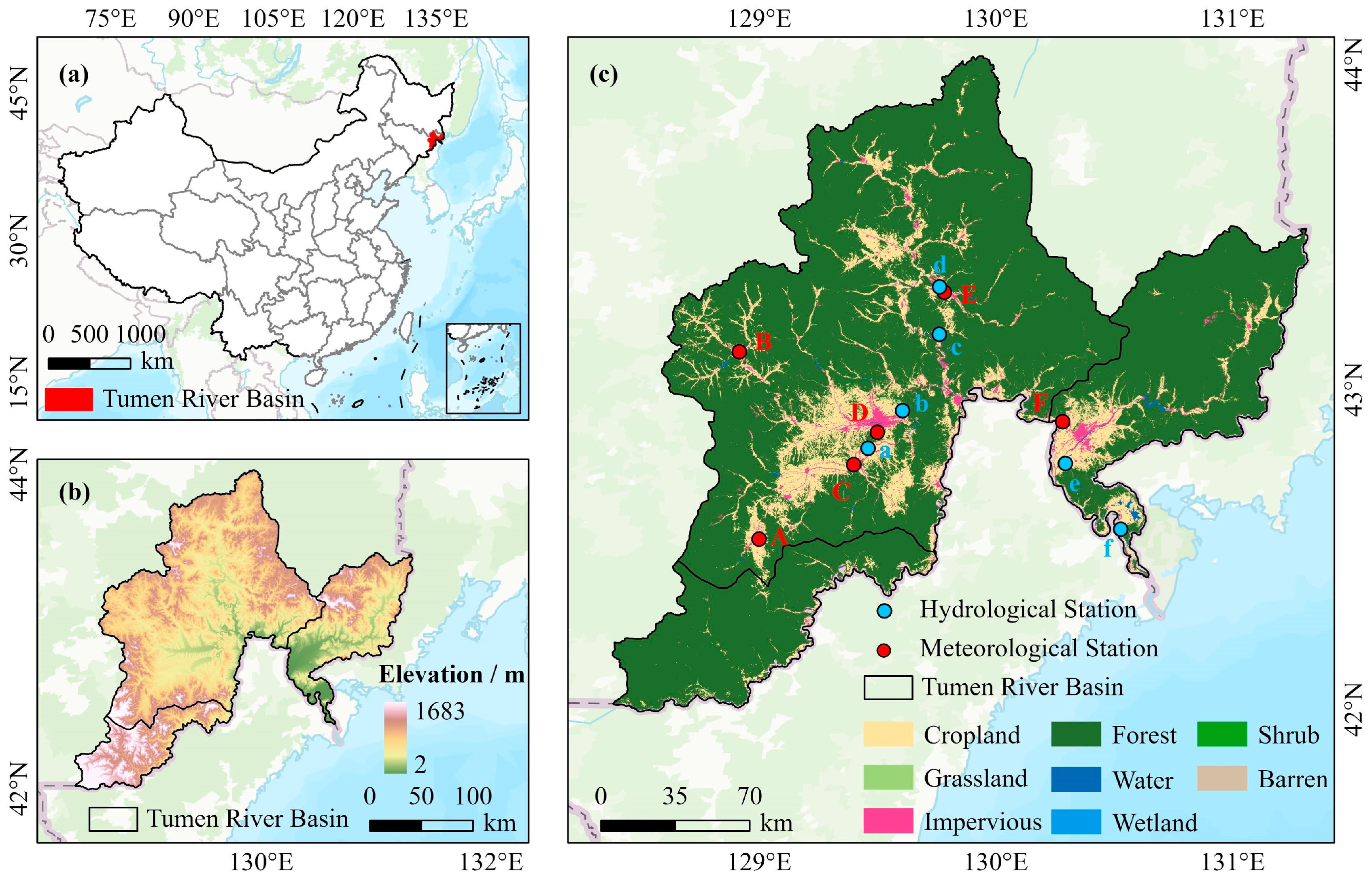
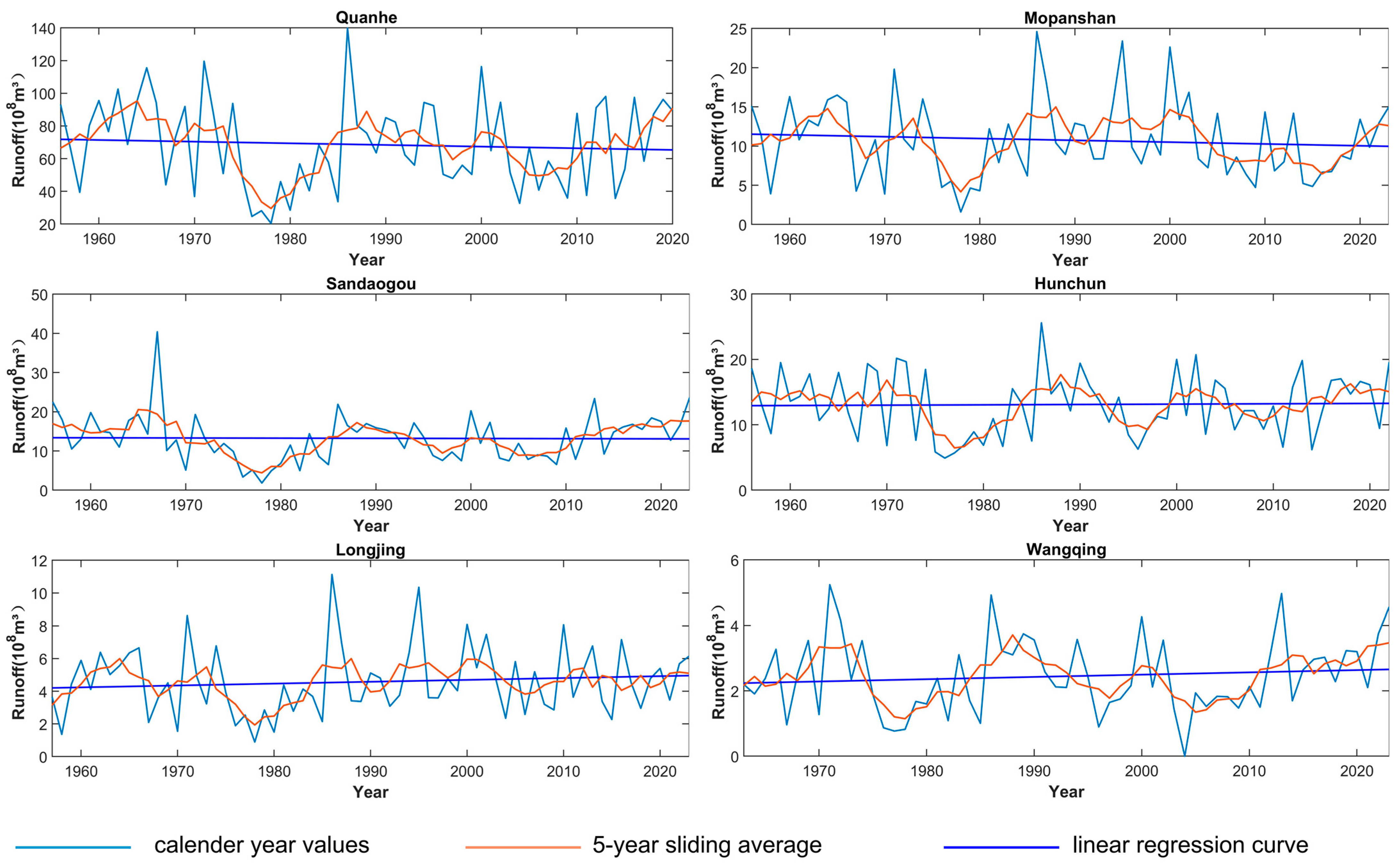
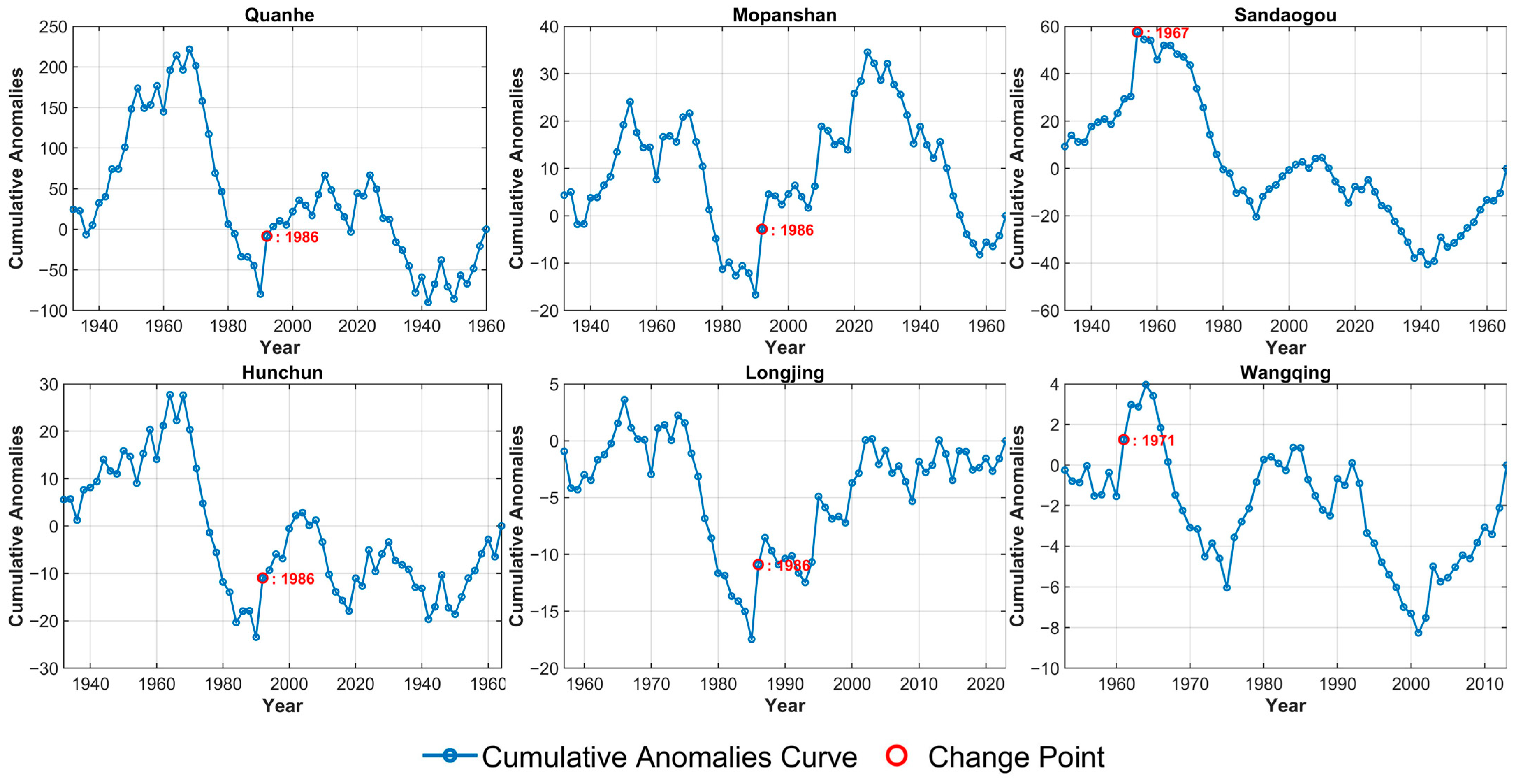

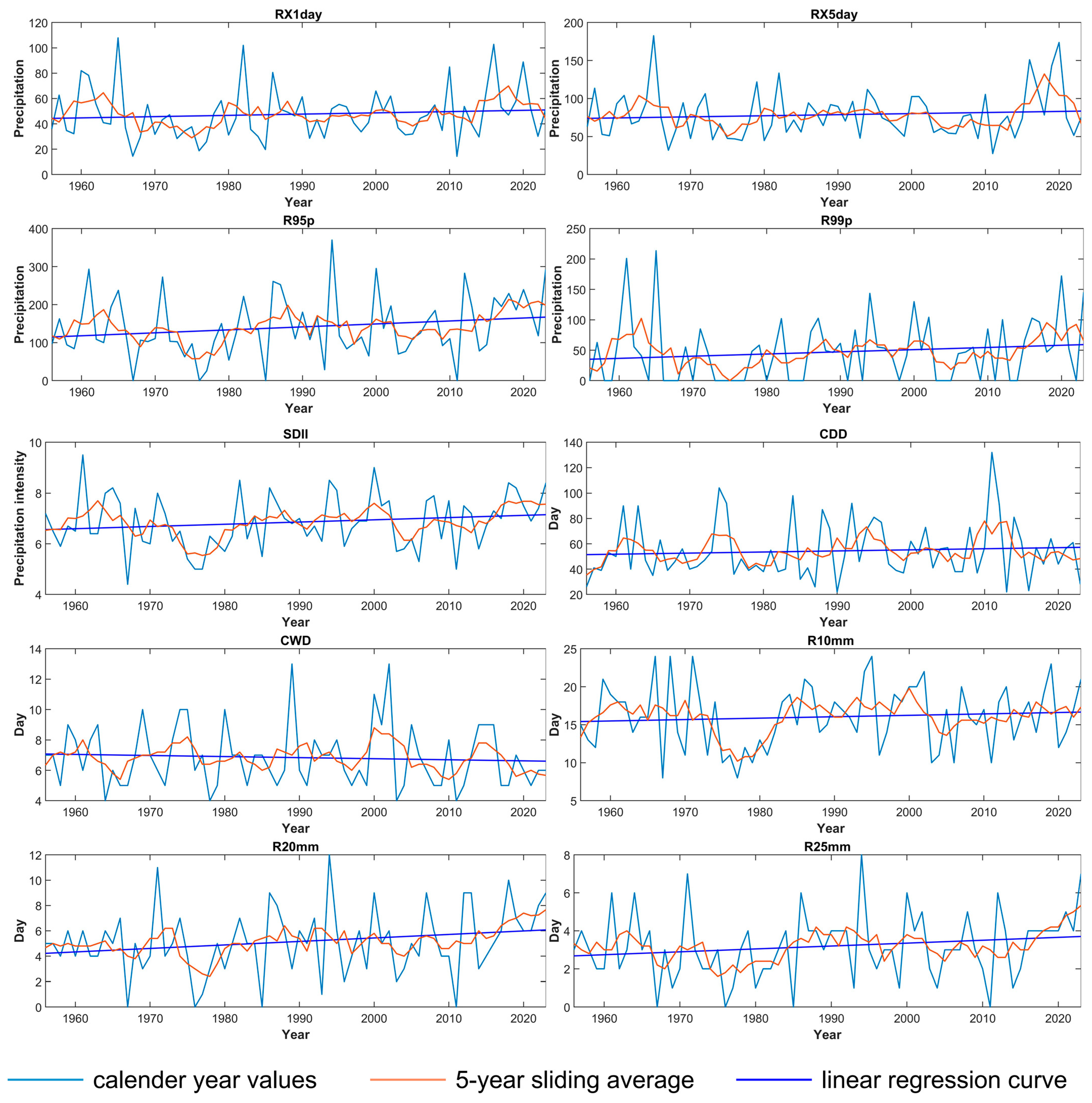
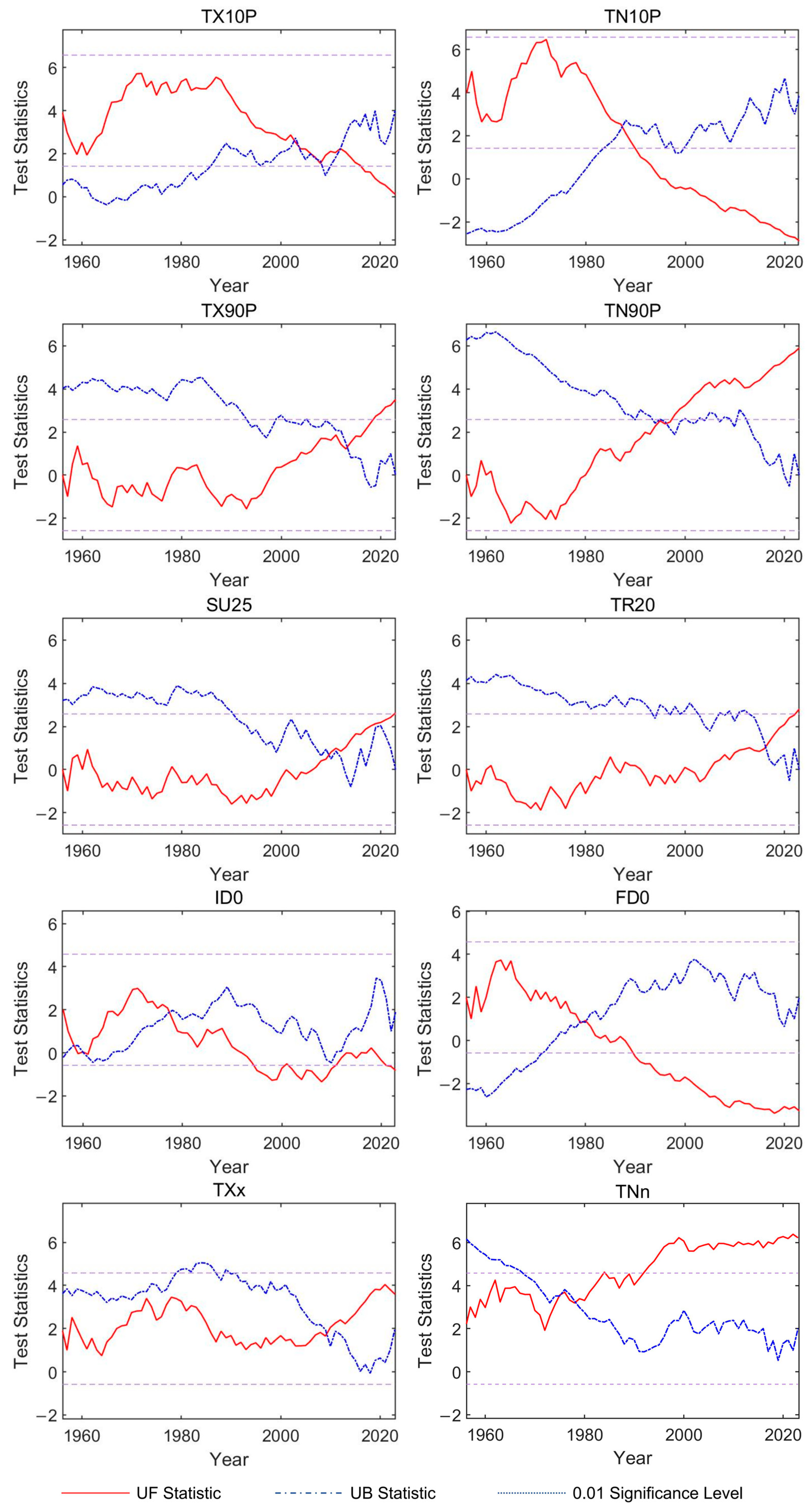
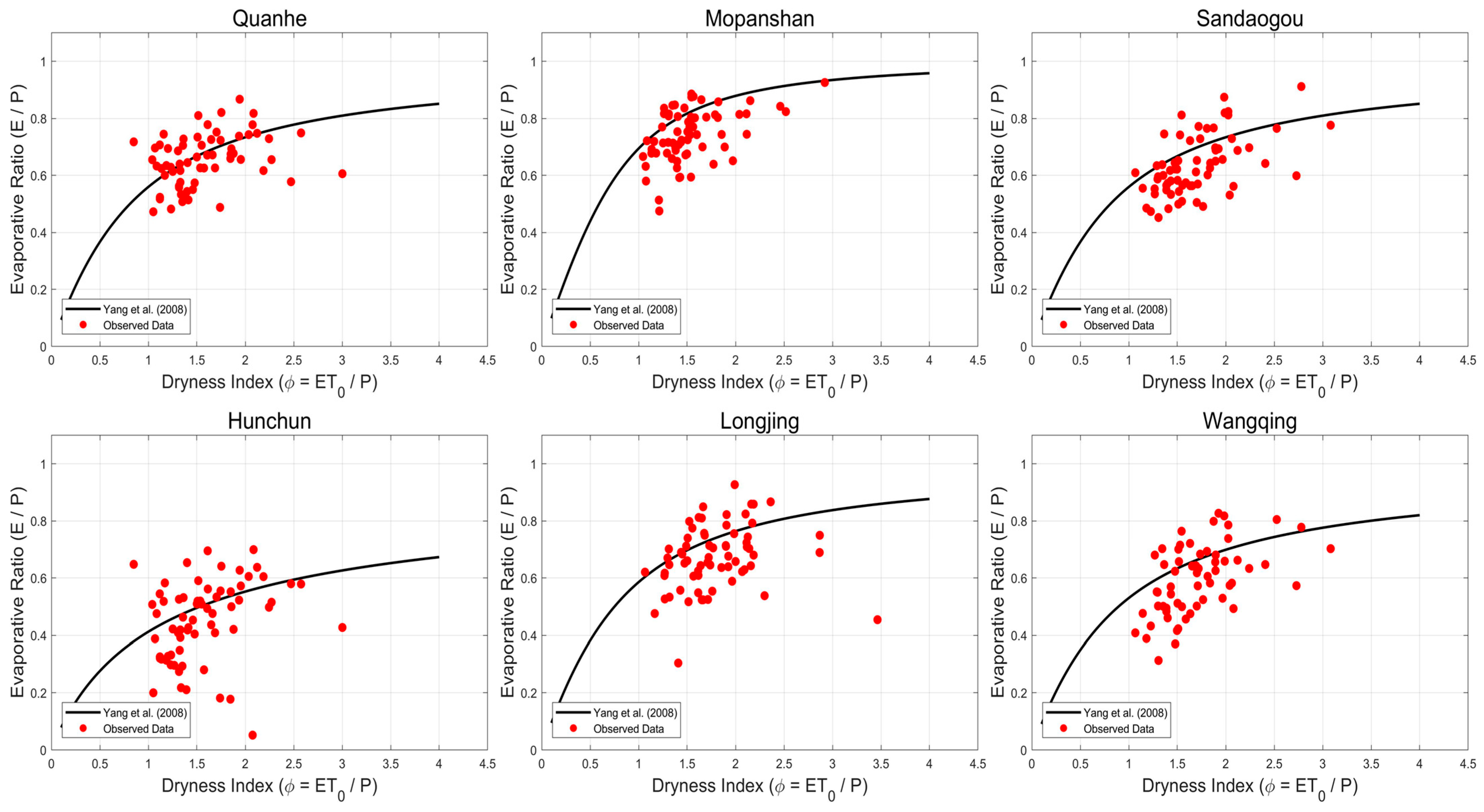
| Site Name | Serial Number | Longitudes (E) | Latitude (N) |
|---|---|---|---|
| Longjing | a | 129.46 | 42.82 |
| Mopanshan | b | 129.61 | 42.93 |
| Sandaogou | c | 129.76 | 43.17 |
| Wangqing | d | 129.76 | 43.32 |
| Hunchun | e | 130.29 | 42.77 |
| Quanhe | f | 130.53 | 42.56 |
| Site Name | Serial Number | Longitudes (E) | Latitude (N) |
|---|---|---|---|
| Helong | A | 129 | 42.53 |
| Antu | B | 128.92 | 43.12 |
| Longjing | C | 129.4 | 42.77 |
| Yanji | D | 129.5 | 42.87 |
| Wangqing | E | 129.78 | 43.3 |
| Hunchun | F | 130.28 | 42.9 |
| ID | Indicator Name | Definitions | UNITS |
|---|---|---|---|
| FD0 | Frost days | Annual count when TN (daily minimum) < 0 °C | Days |
| SU25 | Summer days | Annual count when TX (daily maximum) > 25 °C | Days |
| ID0 | Ice days | Annual count when TX (daily maximum) < 0 °C | Days |
| TR20 | Tropical nights | Annual count when TN (daily minimum) > 20 °C | Days |
| GSL | Growing season length | Annual (1 January to 31 December in NH, 1 July to 30 June in SH) count between first span of at least 6 days with TG > 5 °C and first span after 1 July (1 January in SH) of 6 days with TG < 5 °C | Days |
| TXx | Max Tmax | Monthly maximum value of daily maximum temp | °C |
| TNx | Max Tmin | Monthly maximum value of daily minimum temp | °C |
| TXn | Min Tmax | Monthly minimum value of daily maximum temp | °C |
| TNn | Min Tmin | Monthly minimum value of daily minimum temp | °C |
| TN10p | Cool nights | Percentage of days when TN < 10th percentile | Days |
| TX10p | Cool days | Percentage of days when TX < 10th percentile | Days |
| TN90p | Warm nights | Percentage of days when TN > 90th percentile | Days |
| TX90p | Warm days | Percentage of days when TX > 90th percentile | Days |
| WSDI | Warm spell duration indicator | Annual count of days with at least 6 consecutive days when TX > 90th percentile | Days |
| CSDI | Cold spell duration indicator | Annual count of days with at least 6 consecutive days when TN < 10th percentile | Days |
| DTR | Diurnal temperature range | Monthly mean difference between TX and TN | °C |
| RX1day | Max 1-day precipitation amount | Monthly maximum 1-day precipitation | Mm |
| Rx5day | Max 5-day precipitation amount | Monthly maximum consecutive 5-day precipitation | Mm |
| SDII | Simple daily intensity index | Annual total precipitation divided by the number of wet days (defined as PRCP ≥ 1.0 mm) in the year | Mm/day |
| R10 | Number of heavy precipitation days | Annual count of days when PRCP ≥ 10 mm | Days |
| R20 | Number of very heavy precipitation days | Annual count of days when PRCP ≥ 20 mm | Days |
| Rnn | Number of days above nn mm | Annual count of days when PRCP ≥ nn mm; nn is user-defined threshold | Days |
| CDD | Consecutive dry days | Maximum number of consecutive days with RR < 1 mm | Days |
| CWD | Consecutive wet days | Maximum number of consecutive days with RR ≥ 1 mm | Days |
| R95p | Very wet days | Annual total PRCP when RR > 95th percentile | mm |
| R99p | Extremely wet days | Annual total PRCP when RR > 99th percentile | mm |
| PRCPTOT | Annual total wet-day precipitation | Annual total PRCP on wet days (RR ≥ 1 mm) | mm |
| Basin | Station | Catchment Area (km2) | Runoff Amount (billion m3) | Runoff Depth (mm) | Slope (mm/10a) | Trends | p-Value |
|---|---|---|---|---|---|---|---|
| Mainstem | Quanhe | 31,800 | 68.58 | 215.67 | −1.01 | decline | >0.05 |
| Burgharton River | Mopanshan | 6847 | 10.74 | 166.04 | −0.23 | decline | >0.05 |
| Gaya River | Sandaogou | 6082 | 13.23 | 217.49 | −0.04 | decline | >0.05 |
| Hunchun River | Hunchun | 3836 | 13.28 | 341.37 | 0.05 | upward | >0.05 |
| Hyland River | Longjin | 2567 | 4.58 | 178.43 | 0.11 | upward | >0.05 |
| Wangqing River | Wangqing | 1090 | 2.44 | 227.62 | 0.07 | upward | >0.05 |
| Type | 1976–1986 | 1986–1996 | 1996–2006 | 2006–2017 | |
|---|---|---|---|---|---|
| Single Land Use Dynamic Degree | Artificial surfaces | 0.37% | 0.42% | 2.04% | −0.15% |
| Reservoirs | 9.32% | −2.17% | 16.17% | 8.18% | |
| Cropland | 0.19% | −0.09% | −0.06% | −0.03% | |
| Woodland | 0.00% | 0.05% | −0.02% | 0.01% | |
| Watersheds | −1.88% | −1.44% | −1.27% | −0.47% | |
| Grasslands | −0.21% | −1.32% | −1.28% | −0.71% | |
| Bare land | 4.90% | −2.11% | 6.75% | −6.40% | |
| Comprehensive Land Use Dynamic Degree | 0.04% | 0.05% | 0.05% | 0.02% | |
| Basion | Periods | P/mm | R/mm | ET0/ mm | n | Elasticity | ||||
|---|---|---|---|---|---|---|---|---|---|---|
| εP | Trends | εET0 | εn | Trends | ||||||
| Mainstem | Base | 589.82 | 204.38 | 888.87 | 1.223 | 0.445 | ↑ | −0.0005 | 0.420 | ↓ |
| Human activity | 622.50 | 222.83 | 906.65 | 1.202 | 0.448 | −0.0005 | 0.376 | |||
| Burgharton River | Base | 488.69 | 206.23 | 910.98 | 0.997 | 0.35 | ↑ | −0.0013 | 0.407 | ↓ |
| Human activity | 542.79 | 226.39 | 915.57 | 0.943 | 0.379 | −0.0011 | 0.344 | |||
| Gaya River | Base | 588.22 | 252.22 | 880.23 | 0.945 | 0.406 | ↑ | −0.001 | 0.372 | ↓ |
| Human activity | 542.56 | 198.24 | 894.26 | 1.098 | 0.428 | −0.0013 | 0.253 | |||
| Hunchun Rive | Base | 589.82 | 315.29 | 888.87 | 0.769 | 0.422 | ↑ | −0.0008 | 0.309 | ↓ |
| Human activity | 623.64 | 357.90 | 907.00 | 0.719 | 0.433 | −0.0007 | 0.295 | |||
| Hyland River | Base | 487.93 | 154.99 | 903.83 | 1.174 | 0.327 | ↑ | −0.0016 | 0.354 | ↓ |
| Human activity | 569.28 | 196.31 | 921.99 | 1.159 | 0.364 | −0.0013 | 0.265 | |||
| Wangqing River | Base | 531.91 | 206.89 | 882.12 | 1.023 | 0.373 | ↑ | −0.0012 | 0.315 | ↓ |
| Human activity | 546.67 | 230.75 | 894.90 | 0.964 | 0.383 | −0.0011 | 0.310 | |||
| Basin | dRP/mm | dRET0/mm | dRn/mm | dR/mm | nP/% | nET0/% | nh/% |
|---|---|---|---|---|---|---|---|
| Mainstem | 12.33 | −0.02 | 6.15 | 18.45 | 66.79% | −0.12% | 33.33% |
| Burgharton River | 18.91 | −0.03 | 1.26 | 20.16 | 93.8% | −0.02% | 6.23% |
| Gaya River | −18.53 | −0.01 | −35.43 | −53.98 | 34.33% | 0.02% | 65.64% |
| Hunchun River | 14.27 | −0.01 | 28.36 | 42.61 | 33.48% | −0.03% | 66.55% |
| Hyland River | 26.56 | −0.03 | 14.79 | 41.32 | 64.29% | −0.07% | 35.78% |
| Wangqing River | 6.29 | −0.01 | 17.58 | 23.87 | 26.36% | −0.01% | 73.65% |
Disclaimer/Publisher’s Note: The statements, opinions and data contained in all publications are solely those of the individual author(s) and contributor(s) and not of MDPI and/or the editor(s). MDPI and/or the editor(s) disclaim responsibility for any injury to people or property resulting from any ideas, methods, instructions or products referred to in the content. |
© 2025 by the authors. Licensee MDPI, Basel, Switzerland. This article is an open access article distributed under the terms and conditions of the Creative Commons Attribution (CC BY) license (https://creativecommons.org/licenses/by/4.0/).
Share and Cite
Huo, D.; Wu, J.; Zhao, C.; Yan, Y.; Zhu, W.; Jin, R.; Zhou, J. Identification of Attribution of Runoff Variations in the Tumen River Basin Based on Budyko’s Hypothesis. Hydrology 2025, 12, 122. https://doi.org/10.3390/hydrology12050122
Huo D, Wu J, Zhao C, Yan Y, Zhu W, Jin R, Zhou J. Identification of Attribution of Runoff Variations in the Tumen River Basin Based on Budyko’s Hypothesis. Hydrology. 2025; 12(5):122. https://doi.org/10.3390/hydrology12050122
Chicago/Turabian StyleHuo, Dongqing, Jiaqi Wu, Chunzi Zhao, Yongtao Yan, Weihong Zhu, Ri Jin, and Jingya Zhou. 2025. "Identification of Attribution of Runoff Variations in the Tumen River Basin Based on Budyko’s Hypothesis" Hydrology 12, no. 5: 122. https://doi.org/10.3390/hydrology12050122
APA StyleHuo, D., Wu, J., Zhao, C., Yan, Y., Zhu, W., Jin, R., & Zhou, J. (2025). Identification of Attribution of Runoff Variations in the Tumen River Basin Based on Budyko’s Hypothesis. Hydrology, 12(5), 122. https://doi.org/10.3390/hydrology12050122







